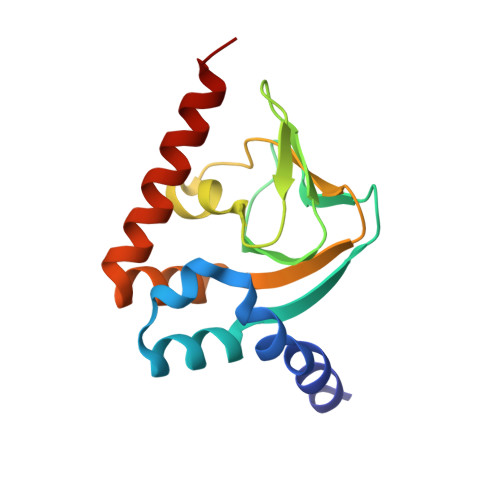Determinants of ligand selectivity in a cyclic nucleotide-regulated potassium channel.
Pessoa, J., Fonseca, F., Furini, S., Morais-Cabral, J.H.(2014) J Gen Physiol 144: 41-54
- PubMed: 24981229
- DOI: https://doi.org/10.1085/jgp.201311145
- Primary Citation of Related Structures:
4MUV - PubMed Abstract:
Cyclic nucleotide-binding (CNB) domains regulate the activity of channels, kinases, exchange factors, and transcription factors. These proteins are highly variable in their ligand selectivity; some are highly selective for either cAMP or cGMP, whereas others are not. Several molecular determinants of ligand selectivity in CNB domains have been defined, but these do not provide a complete view of the selectivity mechanism. We performed a thorough analysis of the ligand-binding properties of mutants of the CNB domain from the MlotiK1 potassium channel. In particular, we defined which residues specifically favor cGMP or cAMP. Inversion of ligand selectivity, from favoring cAMP to favoring cGMP, was only achieved through a combination of three mutations in the ligand-binding pocket. We determined the x-ray structure of the triple mutant bound to cGMP and performed molecular dynamics simulations and a biochemical analysis of the effect of the mutations. We concluded that the increase in cGMP affinity and selectivity does not result simply from direct interactions between the nucleotide base and the amino acids introduced in the ligand-binding pocket residues. Rather, tighter cGMP binding over cAMP results from the polar chemical character of the mutations, from greater accessibility of water molecules to the ligand in the bound state, and from an increase in the structural flexibility of the mutated binding pocket.
Organizational Affiliation:
Instituto de Biologia Molecular e Celular and Instituto de Ciências Biomédicas Abel Salazar, Universidade do Porto, 4150-180 Porto, PortugalInstituto de Biologia Molecular e Celular and Instituto de Ciências Biomédicas Abel Salazar, Universidade do Porto, 4150-180 Porto, Portugal.
















